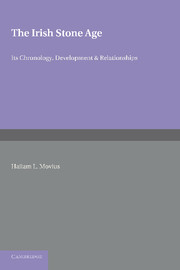Book contents
- Frontmatter
- Dedication
- Contents
- ILLUSTRATIONS
- FOREWORD
- PREFACE
- INTRODUCTION
- Part One THE CHRONOLOGY OF THE LATE-GLACIAL AND EARLY POST-GLACIAL PERIODS IN NORTHERN AND WESTERN EUROPE
- CHAPTER I The Chronology of Northern Europe
- CHAPTER II The Late-Glacial Sequence in Britain and Ireland
- CHAPTER III Early Post-Glacial Chronology in Britain and Ireland
- Part Two THE STONE AGE CULTURES OF IRELAND
- Appendices I-VI
- REFERENCES CITED IN THE TEXT
- CLASSIFIED LIST OF REFERENCES TO CAVE RESEARCH AND STONE AGE ARCHAEOLOGY IN IRELAND
- ADDENDUM
- INDEX
CHAPTER III - Early Post-Glacial Chronology in Britain and Ireland
from Part One - THE CHRONOLOGY OF THE LATE-GLACIAL AND EARLY POST-GLACIAL PERIODS IN NORTHERN AND WESTERN EUROPE
Published online by Cambridge University Press: 05 June 2016
- Frontmatter
- Dedication
- Contents
- ILLUSTRATIONS
- FOREWORD
- PREFACE
- INTRODUCTION
- Part One THE CHRONOLOGY OF THE LATE-GLACIAL AND EARLY POST-GLACIAL PERIODS IN NORTHERN AND WESTERN EUROPE
- CHAPTER I The Chronology of Northern Europe
- CHAPTER II The Late-Glacial Sequence in Britain and Ireland
- CHAPTER III Early Post-Glacial Chronology in Britain and Ireland
- Part Two THE STONE AGE CULTURES OF IRELAND
- Appendices I-VI
- REFERENCES CITED IN THE TEXT
- CLASSIFIED LIST OF REFERENCES TO CAVE RESEARCH AND STONE AGE ARCHAEOLOGY IN IRELAND
- ADDENDUM
- INDEX
Summary
INTRODUCTION
The degree of correlation between the British Isles and Fennoscandia, revealed by the summary of Late-Glacial events presented in Chapter II, is closer than heretofore established. With Late-Glacial varve clays, fauna, peats, raised beaches and archaeological horizons to work on, the lacunae should be filled in the future. Similarly, the Post-Glacial phenomena reflect the Scandinavian sequence dealt with in Chapter I. As the aim of archaeology is to establish cultures in their true chronological position, these phenomena must now be considered with respect to dating, as well as to the environment in which Mesolithic man lived in Ireland. The relative importance of rise and fall of the land and alterations in the volume of the ocean in producing changes in the mutual relation of land and sea at various periods is not considered here. Thus the terms “submergence” and “emergence”are used throughout this book without any attempt to distinguish between eustatic and isostatic factors.
2. SUBMERGED FORESTS AND RAISED BEACHES
(APPENDIX VI)
A. England & Wales. In this area there are particularly full data concerning the Post-Glacial oscillation of land and sea. The material is far clearer and more obvious than the similar fragmentary evidence of the Late- Glacial Period. The most striking proof of an emergence of the land is afforded by a study of the peat deposits of the Dogger Bank, which are known as moorlog. This usually occurs at a depth of 22-3 fathoms, and great fragments of it are frequently dredged up (Reid, 1913, pp. 41-7). Beetle elytra and plant remains show that the deposit was laid down in a fresh-water fen somewhat removed from the sea. The pollen has been studied by Godwin (1934, p. 340) and Erdtman (1924, pp. 677-8). The published analyses of a total of twenty samples agree in a striking manner, and in fact all but two are almost identical. Birch and Pine are the dominant forest forms in all cases, and this fact indicates a Late Pre-Boreal or Early Boreal date. The two aberrant analyses may be interpreted as indicating the advent of Oak and Hazel in Boreal times. On the margins of the North Sea there are later peats with a spectrum consisting largely of Oak-Mixed-Forest forms indicative of the Early Atlantic Period.
- Type
- Chapter
- Information
- The Irish Stone AgeIts Chronology, Development and Relationships, pp. 75 - 102Publisher: Cambridge University PressPrint publication year: 2013



